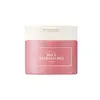What's inside
What's inside
 Key Ingredients
Key Ingredients

 Benefits
Benefits

 Concerns
Concerns

 Ingredients Side-by-side
Ingredients Side-by-side

Glycyrrhiza Uralensis Root Extract
Skin ConditioningButylene Glycol
HumectantGlycerin
Humectant1,2-Hexanediol
Skin ConditioningAllantoin
Skin ConditioningPanthenol
Skin ConditioningArginine
MaskingPolyglyceryl-10 Laurate
Skin ConditioningPolyglyceryl-10 Myristate
Skin ConditioningHydrolyzed Sodium Hyaluronate
Skin ConditioningEctoin
Skin ConditioningGlycyrrhizic Acid
HumectantLactobionic Acid
BufferingAsiaticoside
AntioxidantAsiatic Acid
Skin ConditioningMadecassic Acid
Skin ConditioningPrunus Armeniaca Kernel Oil
MaskingMadecassoside
AntioxidantPogostemon Cablin Leaf Oil
MaskingJuniperus Communis Fruit Oil
MaskingAmyris Balsamifera Bark Oil
MaskingCitrus Nobilis Peel Oil
MaskingCitrus Paradisi Peel Oil
MaskingBetaine Salicylate
AntimicrobialPiper Nigrum Fruit Oil
MaskingVetiveria Zizanoides Root Oil
MaskingGlycyrrhiza Uralensis Root Extract, Butylene Glycol, Glycerin, 1,2-Hexanediol, Allantoin, Panthenol, Arginine, Polyglyceryl-10 Laurate, Polyglyceryl-10 Myristate, Hydrolyzed Sodium Hyaluronate, Ectoin, Glycyrrhizic Acid, Lactobionic Acid, Asiaticoside, Asiatic Acid, Madecassic Acid, Prunus Armeniaca Kernel Oil, Madecassoside, Pogostemon Cablin Leaf Oil, Juniperus Communis Fruit Oil, Amyris Balsamifera Bark Oil, Citrus Nobilis Peel Oil, Citrus Paradisi Peel Oil, Betaine Salicylate, Piper Nigrum Fruit Oil, Vetiveria Zizanoides Root Oil
Water
Skin ConditioningBeta Vulgaris Root Extract
Skin ConditioningGlycerin
HumectantDipropylene Glycol
HumectantPropanediol
SolventNiacinamide
SmoothingErythritol
Humectant1,2-Hexanediol
Skin ConditioningHydroxyacetophenone
AntioxidantCaprylyl Glycol
EmollientDaucus Carota Sativa Root Extract
Skin ConditioningPyrus Malus Fruit Extract
Skin ConditioningPolyglyceryl-10 Laurate
Skin ConditioningAllantoin
Skin ConditioningXanthan Gum
EmulsifyingAdenosine
Skin ConditioningArginine
MaskingCarbomer
Emulsion StabilisingSodium Hyaluronate
HumectantGlyceryl Acrylate/Acrylic Acid Copolymer
HumectantMelia Azadirachta Leaf Extract
Skin ConditioningPvm/Ma Copolymer
Emulsion StabilisingMelia Azadirachta Flower Extract
Skin ConditioningHydrolyzed Gardenia Florida Extract
AntioxidantDipotassium Glycyrrhizate
HumectantBetaine
HumectantCitric Acid
BufferingBetaine Salicylate
AntimicrobialMaltodextrin
AbsorbentPanthenol
Skin ConditioningEthylhexylglycerin
Skin ConditioningCoccinia Indica Fruit Extract
Skin ConditioningCorallina Officinalis Extract
Skin ConditioningPantolactone
HumectantDisodium EDTA
Water, Beta Vulgaris Root Extract, Glycerin, Dipropylene Glycol, Propanediol, Niacinamide, Erythritol, 1,2-Hexanediol, Hydroxyacetophenone, Caprylyl Glycol, Daucus Carota Sativa Root Extract, Pyrus Malus Fruit Extract, Polyglyceryl-10 Laurate, Allantoin, Xanthan Gum, Adenosine, Arginine, Carbomer, Sodium Hyaluronate, Glyceryl Acrylate/Acrylic Acid Copolymer, Melia Azadirachta Leaf Extract, Pvm/Ma Copolymer, Melia Azadirachta Flower Extract, Hydrolyzed Gardenia Florida Extract, Dipotassium Glycyrrhizate, Betaine, Citric Acid, Betaine Salicylate, Maltodextrin, Panthenol, Ethylhexylglycerin, Coccinia Indica Fruit Extract, Corallina Officinalis Extract, Pantolactone, Disodium EDTA
Ingredients Explained
These ingredients are found in both products.
Ingredients higher up in an ingredient list are typically present in a larger amount.
1,2-Hexanediol is a synthetic liquid and another multi-functional powerhouse.
It is a:
- Humectant, drawing moisture into the skin
- Emollient, helping to soften skin
- Solvent, dispersing and stabilizing formulas
- Preservative booster, enhancing the antimicrobial activity of other preservatives
Allantoin is a soothing ingredient known for its protective and moisturizingg properties. Because of this, it is often added to products with strong active ingredients.
Studies show higher concentrations of this ingredient can promote wound healing.
Though it can be derived from the comfrey plant, allantoin is produced synthetically for cosmetic products to ensure purity.
Learn more about AllantoinArginine is an amino acid that is important for human development. Your body uses is it to produce hair keratin and skin collagen.
As a cosmetic ingredient, Arginine has antioxidant properties and can also help repair damaged skin. This ingredient is derived either synthetically or from animals.
Arginine isn't fungal acne safe when used in the presence of other lipids (fats, fatty acids, oils, esters, etc). Oils and fats occur naturally within the skin, so take caution when using Arginine if you're prone to fungal acne.
Learn more about ArginineBetaine Salicylate is considered a salicylic acid alternative.
Limited studies exist proving this ingredient to be a complete alternative to salicylic acid. Based on existing research, this ingredient does not penetrate as deeply and is not shown to be as effective.
However, this makes it a great choice for those with sensitive skin or need gentle BHA action.
This ingredient is created using betaine and salicylic acid.
This ingredient is oil-soluble and is most effective at a pH range of 3.8-4.2.
Learn more about Betaine SalicylateGlycerin is already naturally found in your skin. It helps moisturize and protect your skin.
A study from 2016 found glycerin to be more effective as a humectant than AHAs and hyaluronic acid.
As a humectant, it helps the skin stay hydrated by pulling moisture to your skin. The low molecular weight of glycerin allows it to pull moisture into the deeper layers of your skin.
Hydrated skin improves your skin barrier; Your skin barrier helps protect against irritants and bacteria.
Glycerin has also been found to have antimicrobial and antiviral properties. Due to these properties, glycerin is often used in wound and burn treatments.
In cosmetics, glycerin is usually derived from plants such as soybean or palm. However, it can also be sourced from animals, such as tallow or animal fat.
This ingredient is organic, colorless, odorless, and non-toxic.
Glycerin is the name for this ingredient in American English. British English uses Glycerol/Glycerine.
Learn more about GlycerinPanthenol is a common ingredient that helps hydrate and soothe the skin. It is found naturally in our skin and hair.
There are two forms of panthenol: D and L.
D-panthenol is also known as dexpanthenol. Most cosmetics use dexpanthenol or a mixture of D and L-panthenol.
Panthenol is famous due to its ability to go deeper into the skin's layers. Using this ingredient has numerous pros (and no cons):
Like hyaluronic acid, panthenol is a humectant. Humectants are able to bind and hold large amounts of water to keep skin hydrated.
This ingredient works well for wound healing. It works by increasing tissue in the wound and helps close open wounds.
Once oxidized, panthenol converts to pantothenic acid. Panthothenic acid is found in all living cells.
This ingredient is also referred to as pro-vitamin B5.
Learn more about PanthenolPolyglyceryl-10 Laurate is an ester of lauric acid and Polyglycerin-10.
Polyglyceryl-10 Laurate is a cleansing agent and emulsifier. It helps gather dirt, oil, and other pollutants to be rinsed away. As an emulsifier, it helps prevent ingredients from separating, such as oil and water.
Polyglyceryl-10 Laurate may not be fungal acne safe.
Learn more about Polyglyceryl-10 Laurate